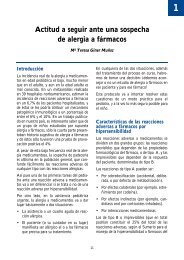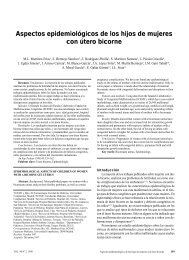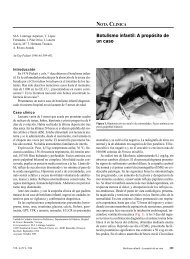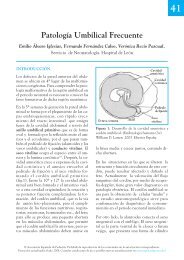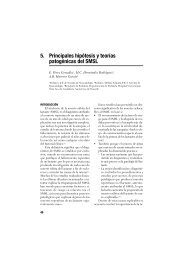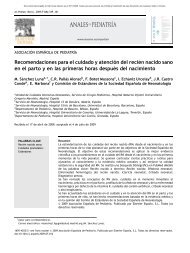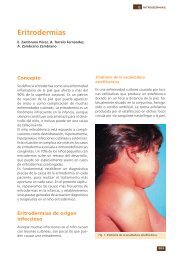Texto completo - Asociación Española de Pediatría
Texto completo - Asociación Española de Pediatría
Texto completo - Asociación Española de Pediatría
You also want an ePaper? Increase the reach of your titles
YUMPU automatically turns print PDFs into web optimized ePapers that Google loves.
Heyningen V. A FISH approach to <strong>de</strong>fining the extent and possible<br />
clinical significance of <strong>de</strong>letions at the WAGR locus. J Med Genet<br />
1997; 34:207-212.<br />
18 Wa<strong>de</strong>y RB, Pal N, Buckle B, Yeomans E, Pritchard J, Cowell JK. Loss<br />
of heterozygosity in Wilm’s tumour involves two distinct region of<br />
chromosome 11. Oncogene 1990; 5:901-907.<br />
19 Gessler M, Koning A, Bruns GA. The genomic organization and expression<br />
of the WT1 gene. Genomic 1992; 12:807-813.<br />
20 Bonetta L, Kuehn SE, Huang A et al. Wilm’s tumor locus on 11p13<br />
<strong>de</strong>fined by multiple CpG island-associated transcripts. Science 1990;<br />
250:994-997.<br />
21 Haber DA, Housman DE. Role of the WT1 gene in Wilms’tumour.<br />
Cancer Surv 1992; 12:105-117.<br />
22 Rauscher FJ. The WT1 Wilms tumor gene product: A <strong>de</strong>velopementally<br />
regulated transcription factor in the kidney that functions as a tumor<br />
suppresor. FASEBJ 1993; 7:896-903.<br />
23 Little MH, Prosser J, Condie A, Smith PJ, Van Heyningen V, Hastie<br />
ND. Zinc finger point mutations whitin the WT1 gene in Wilms tumor<br />
patients. Proc Natl Acad Sci USA 1992; 89:4791-4795.<br />
24 Kaplinsky C, Ghahremani M, Frishberg Y, Rechavi G, Pelletier J.<br />
Familial Wilms’tumor associated with a WT1 zinc finger mutation.<br />
Genomic 1996; 38:451-453.<br />
25 Little M, Wells C. A clinical overview of WT1 gene mutations. Hum<br />
Mutat 1997; 9:209-225.<br />
26 Park S, Schhalling M, Bernard A et al. The Wilms tumour gene WT1<br />
is expressed in murine meso<strong>de</strong>rm-<strong>de</strong>rived tissues and mutated in a human<br />
mesothelioma. Nat Genet 1993; 4:415-420.<br />
27 Pritchart K, Renshaw J, King L. The Wilms tumour (WT1) gene is<br />
mutated in a secondary leukemia in a WAGR patient. Hum Mol Genet<br />
1994; 3:1633-1637.<br />
28 Hoovers JM, Kalikin LM, Johnson LA et al. Multiple genetic loci within<br />
11p15 <strong>de</strong>fined by Beckwith-Wie<strong>de</strong>mann syndrome rearrangement<br />
breakpoint and subcromosomal transferable fragments. Proc Natl Acad<br />
Sci 1995; 92:12456-12460.<br />
29 Weksberg R, Shen DR, Fei YL, Song QL, Squire J. Disruption of insulin-like<br />
growth factor 2 imprinting in Beckwith-Wie<strong>de</strong>mann syndrome.<br />
Nature Genet 1993; 5:143-150.<br />
30 Lee MP, Hu RJ, Johnson LA, Feinberg AP. Human KVLQT1 gene<br />
shows tissue-specific imprinting and encompases Beckwith-Wiemann<br />
syndrome chromosomal rearrangements. Nat Genet 1997; 15:181-185.<br />
31 Giannoukakis N, Deal C, Paquette J, Goodyear CG, Polychronatos C.<br />
Parental imprinting of the human IGF2 gene. Nat Genet 1993; 4:98-101.<br />
32 Catchpoole D, Lam WW, Valler D, Temple IK, Joyce JA, Reik W,<br />
Schofield PN, Maher ER. Epigenetic modification and uniparental inherence<br />
of H19 in Beckwith-Wie<strong>de</strong>mann syndrome. J Med Genet 1997;<br />
34:353-359.<br />
33 Hatada I, Inazawa J, Abe T et al. Genomic imprinting of human<br />
p57KIP2 and its reduced expression in Wilms tumors. Hum Mol Genet<br />
1996; 5:783-788.<br />
34 Weng EY, Mortier GR, Graham JM Jr. Beckwith-Wie<strong>de</strong>mann syndrome:<br />
An update and review for the primary pediatrician. Clin Pediatr<br />
1995; 34:317-326.<br />
35 Maw MA, Grunddy PE, Millow LJ et al. A third Wilms’s tumor locus<br />
on chromosome 16q. Cancer Res 1992; 52:3094-3098.<br />
36 Grundy PE, Telzerow PE, Breslow N, Moksness J, Huff V, Paterson<br />
MC. Loss of heterozygosity for chromosome 16q and 1p in Wilms’s<br />
tumor predicts and adverse outcome. Cancer Res 1994; 54:2331-1333.<br />
37 Grundy P, Coppes MJ, Haber D. Molecular genetics of Wilms tumor.<br />
Hematol Oncol Clin North Am 1995; 9:1201-1215.<br />
38 Besnard-Guerin, Newsham I, Winqvist R, Cavenee WK. A common<br />
region of loss of heterozygosity in Wilms’s tumor and embryonal rhabdomyosarcoma<br />
distal to the D11S988 locus on chromosome 11p15.5.<br />
Hum Genet 1996; 97:163-170.<br />
39 Gerald WL.The molecular genetics of Wilms tumor: a paradigm of heterogenneity<br />
in tumor <strong>de</strong>velopment. Cancer Invest 1994; 12:350-359.<br />
40 Glaser T, Walton DS, Mas RL. Genomic structure, evolutionary conservation<br />
and aniridia mutations in the human PAX6 gene. Nature<br />
Genetics 1992; 2:232-239.<br />
41 Ton CCT, Hirvonen H, Miwa H et al. Positional cloning and characterization<br />
of a paired box-and homeobox-containing gene from the aniridia<br />
region. Cell 1991; 67:1059-1074.<br />
42 Hanson IM, Seawright A, Hardman K, Hodgson S, Zaletayed D, Fekete<br />
G, Van Heyningen V. PAX6 mutations in aniridia. Hum Mol Genet<br />
1993; 2:915-920.<br />
43 Jordan T, Hanson I, Zaletayed D et al. The human PAX6 gene is mutated<br />
in two patients with aniridia. Nature Genet 1992; 1:328-332.<br />
44 Martha AD, Ferrell RE, Mintz H, Lyons L, Saun<strong>de</strong>rs GF. Paired box<br />
mutations in familial and sporadic aniridia predicts truncated aniridia<br />
proteins. Am J Hum Genet 1994; 54:801-811.<br />
45 Drechsler M, Royer B. A LINE element is present at the site of a 300<br />
kb <strong>de</strong>letion starting in intron 10 of the PAX6 gene in a case of familial<br />
aniridia. Hum Genet 1996; 98:297-303.<br />
46 Glaser T, Jepeal L, Edward JG, Young SR, Favor J, Mass RL. PAX6<br />
gene dosage effect in a family with congenital cataracts, aniridia, anophthalmia<br />
an central nervous system <strong>de</strong>fects. Nature Genetics 1994; 7:463-<br />
471.<br />
47 Hanson IM, Fletcher JM, Jordan T et al. Mutations at the PAX6 locus<br />
are found in hetrogeneous anterior segment malformations including<br />
Peter’s anomaly. Nature Genet 1994; 6:168-173.<br />
48 van Heyningen V, Bickmore WA, Seawright A et al. Role for the tumor<br />
gene in genital <strong>de</strong>velopment?. Proc Natl Acad Sci 1990; 87:5383-<br />
5386.<br />
49 Kreidber JA, Sariola H, Loring JM, Maeda M, Pelletier J, Housman<br />
D, Jaenisch R. WT-1 is requires for early kidney <strong>de</strong>velopment. Cell<br />
1993; 74:679-691.<br />
50 Schumacher V, Schnei<strong>de</strong>r S, Figge A et al. Correlation of germ-line<br />
mutations ans two-hit inactivation of the WT1 gene with Wilms tumors<br />
of stromal-predominant histology. Proc Natl Acad Sci 1997;<br />
94:3972-3977.<br />
51 Bruening W, Bar<strong>de</strong>essy N, Silverman BL et al. Germline intronic and<br />
exoninc mutations in the Wilms’tumour gene (WT1) affecting urogenital<br />
<strong>de</strong>velopment. Nature Genet 1992; 1:144-148.<br />
52 Pelletier J, Brueniing W, Li FP, Haber DA, Glaaser T, Housman DE.<br />
WT1 mutations contribute to abnormal genital system <strong>de</strong>velopment<br />
and hereditary Wilms’ tumour. Nature 1991; 353:431-434.<br />
53 Little M, Holmes G, Bickmore W, van Heyningen V, Hastie N,<br />
Wainwright B. DNA binding capacity of the WT1 protein abolished<br />
by Denys-Drash syndrome WT1 point mutation. Hum Mol Genet 1995;<br />
4:351-358.<br />
54 Little MH, Williamson KA, Mannens M, Kelsey A, Gos<strong>de</strong>n C, Hastie<br />
ND, van Heyningen V. Evi<strong>de</strong>nce that WT1 mutations in Denys-Drash<br />
syndrome patients may act in a dominant-negative fashion. Hum Molec<br />
Genet 1993; 2:259-264.<br />
55 Schwartz F, Neve R, Eisenman R, Gessler M, Bruns GAP. A WAGR<br />
region gene between PAX6 and FSHB expressed in fetal brain. Hum<br />
Genet 1994; 94:658-664.<br />
386 M. Moreno García y cols. ANALES ESPAÑOLES DE PEDIATRIA



